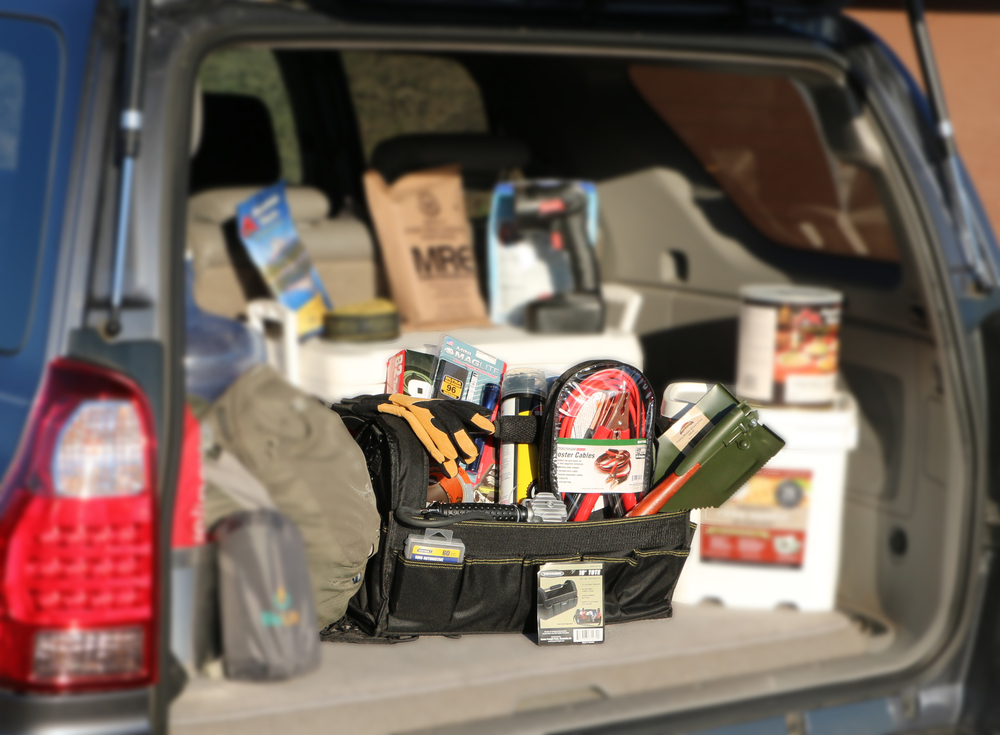If you're still trying to figure out which type of bug out vehicle is best you're not alone. It's best to do research to ensure you'll have a reliable car to count on when SHTF. As well as having the right vehicle, you also need the right supplies in your rig as well. The following list serves as a small example of things you can add to you portable bugout kit.
The type of vehicle you drive, first and foremost, is important. If you live in an area where there is ice and snow during the winter months, you should consider having at least one vehicle that has four-wheel drive. Most vehicles – even compacts – have enough trunk or backseat space for a decent-sized bugout kit, so space shouldn’t be a huge problem. Still, a small sports car is pretty much a non-starter; you need something with storage space. Keep your vehicle serviced regularly and make repairs in a timely manner. Also, keep at least a half-tank of gas in the fuel tank at all times.
Communication will be important so keep a cell phone charger in your car. In a total disaster scenario, you may not have cell service, of course, but you won’t know ahead of time, so a charger is a good thing to toss into your glove box. If you don’t have a charger, keep your cell phone off in between uses to save your battery. Portable CB radios are also good to keep in your kit; don’t forget extra batteries or, better still, a battery charger that can run off your car battery. (Note: More and more newer cars are being built without the old time cigarette lighters – is your vehicle one of them? Plan ahead.)
Also, think about placing a small crank-charge AM/FM/Weather Band radio in your kit as well. Your car radio will suffice as long as you’re driving but if you have to abandon it at some point, you’ll have a backup.
Don’t forget to pack flashlights and, of course, spare batteries. Small, high-powered flashlights will serve their purpose and take up less space.
Paper maps of your area and surrounding areas can prove to be invaluable. Too often these days, we pull up Google Maps on our phones, but again, if service becomes unavailable, so too will Google Maps. You might also consider a portable GPS device; while life on your spot of the world might be chaotic, chances are the GPS satellites are still going to be operational. Just a thought.
Food and water in your vehicle kit is, of course, a must. Since your vehicle is often exposed to varying temperature extremes, you’ll want to rotate your food and water fairly often, say every month or so. Think about foods that don’t need to be reconstituted with water, because the latter is going to prove more vital to your survival, no matter the weather (although in winter, if there is snow on the ground, you will have a ready water re-supply). One brand, Aqua Blox, comes in 8-ounce containers and claims to have a five-year shelf life, according to Popular Mechanics.
A “space blanket” and some chemical heating packs are a good idea as well, even if you live in “warm” climates (because it generally cools off at night, even in the desert). Wool blankets work well even if they’re damp (which is why the U.S. Army still uses them).
Take the time to find a decently equipped first aid pack, and not one with just a few band-aids. Like the bug-out bag at your house, you’ll want to ensure you have in your vehicle bug-out kit things like allergy meds (if you are allergic to the wilderness), pain relievers and such.
Even if you’re not “handy” with tools, pick up a fairly well-stocked took kit that includes a crowbar, hammer, adjustable wrench, and various sizes of flat-head and Phillips screwdrivers. If space is a problem, consider an all-in-one tool like a Leatherman Tool. Another good tool to have is a small shovel, like the kind the military issues. Glock – the weapons maker – also makes a pretty good folding model.
If you’re trained in the use of firearms it’s always a good idea to keep one in your vehicle as part of your overall mobile preparedness, along with some additional ammunition. As always, check with your local authorities to find out what the laws are in your area regarding the carrying of firearms in your vehicle.
Do you have a decent spare tire in your trunk? This may seem foolish, but if your vehicle has one of those “space saver” spares, just keep in mind that those are only designed to take you a short distance to a tire repair shop (which won’t be an option if the SHTF). Best to spend the extra money on a good spare if you can.
What do you plan on adding your vehicle bugout kit?
I think having enough tools is wise, especially if you're going to be on the road for a while. If your car were to break down you'll be glad you have the proper tools on hand.
Heating blankets are also important because if you're bugging out and get lost an extra blanket may be what keeps you alive. Plan accordingly and you should be all set for a pivotal SHTF situation!
Source: Bugout.news
Featured Image via Bugout.news
